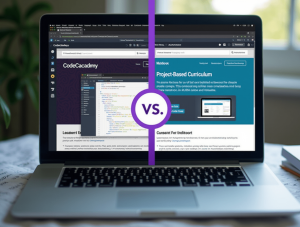
Did you know that 87% of developers report teaching themselves a new programming language or framework without any formal education? As tech skills become increasingly vital across industries, platforms like Udacity and Pluralsight have emerged as leading alternatives to traditional education for building career-relevant technical capabilities.
If you’re evaluating these two major tech learning platforms, you’re likely facing a significant decision that impacts both your professional development and your wallet. Both promise to transform your technical skills, but they take markedly different approaches to curriculum design, learning methodology, and career support.
In this comprehensive comparison, we’ll analyze what truly matters when choosing between Udacity and Pluralsight: content quality, learning approaches, industry recognition, pricing models, and career outcomes. By the end, you’ll understand exactly which platform aligns with your specific learning style, career ambitions, and budget constraints.
The Evolution of Tech Learning Platforms
Understanding the Background
Before diving into our detailed comparison, it helps to understand the origins and missions of these educational platforms:
Udacity was founded in 2011 by Sebastian Thrun, a Stanford professor and Google X founder, after his Stanford AI course attracted over 160,000 students online. The platform evolved from this experiment into what they call “Nanodegree programs” – focused tech curricula developed in collaboration with industry leaders like Google, AWS, and Microsoft.
Pluralsight began in 2004 as a classroom-based training company before transitioning to online learning in 2007. The platform focuses on providing comprehensive technology skill development across a vast library of courses, with particular strength in software development, IT operations, data, and security.
Both platforms emerged to address the growing gap between traditional education and rapidly evolving tech industry needs, but they’ve developed distinct approaches to solving this problem.
Course Offerings and Content Quality
Udacity’s Nanodegree Programs
Udacity structures its learning around approximately 60 Nanodegree programs across several tech domains:
Focus Areas:
- Data Science and AI/ML
- Programming and Software Development
- Cloud Computing
- Business (Product Management, Marketing)
- Autonomous Systems
- Cybersecurity
Content Structure:
- Project-based curriculum (4-6 projects per Nanodegree)
- Industry-partner developed content
- 3-6 month completion timeframes
- Human mentorship and project reviews
- Career services and portfolio development
Content Development Approach:
- Co-created with leading companies (Google, AWS, Intel, etc.)
- Emphasis on practical, employable skills
- Regular updates to match industry evolution
- Focus on cutting-edge and emerging technologies
Pluralsight’s Library Model
Pluralsight offers a vast catalog of over 7,500 courses across technology domains:
Focus Areas:
- Software Development (multiple languages and frameworks)
- IT Operations
- Information & Cyber Security
- Data Professional
- Architecture & Construction
- Manufacturing & Design
- Business Professional
Content Structure:
- Individual courses grouped into skill paths
- Role-based learning paths
- Interactive courses and projects
- Skill assessments and analytics
Content Development Approach:
- Created by industry experts and practitioners
- Author-led development model
- Regular refreshes of popular content
- Comprehensive coverage from foundational to advanced topics
Content Quality Comparison
The platforms take fundamentally different approaches to content:
- Udacity emphasizes depth over breadth, with carefully structured Nanodegrees that dive deeply into specific technical domains. The content is highly curated and organized into cohesive programs rather than standalone courses.
- Pluralsight prioritizes comprehensive coverage, offering courses on virtually every technical skill imaginable. Their model allows for greater breadth but varies more in depth depending on the specific course and author.
Content quality considerations:
- For cutting-edge technologies: Udacity often has an edge due to its industry partnerships
- For breadth of topics: Pluralsight’s massive library provides unmatched coverage
- For cohesive learning paths: Udacity’s Nanodegree structure provides clearer progression
- For depth of specific technical skills: Quality depends on the specific topic area
Learning Experience and Teaching Methodology
Udacity’s Learning Model
Udacity employs a highly structured project-based learning approach:
Core Components:
- Video lessons with industry experts
- Coding exercises and quizzes
- Major projects that simulate real-world applications
- Personal mentorship and technical support
- Human project reviews with specific feedback
Learning Experience:
- Cohort-based progression possible
- Emphasis on building portfolio-worthy projects
- High accountability through deadlines
- Active learning with practical application
- Detailed feedback on submitted work
Support Structure:
- Technical mentors available via chat
- Project reviewers provide personalized feedback
- Community forums for peer assistance
- Career coaching for some programs
Pluralsight’s Learning Model
Pluralsight uses a self-paced, comprehensive approach:
Core Components:
- Video-based instruction from industry practitioners
- Interactive course exercises
- Hands-on labs in real environments
- Skill assessments and IQ measurements
- Role-based and skill-based learning paths
Learning Experience:
- Completely self-paced progression
- Skill measurement and benchmarking
- Personalized course recommendations
- Multiple instructors with different teaching styles
- Choose-your-own-adventure flexibility
Support Structure:
- Course discussion forums
- Content-specific Q&A
- Author interactions on some courses
- Technical support for platform issues
Learning Experience Comparison
The learning models reflect different educational philosophies:
- Udacity follows a guided apprenticeship model, emphasizing learning-by-doing through substantial projects with expert feedback. This approach requires more time commitment but often results in deeper practical skills.
- Pluralsight employs a library model with self-assessment tools, allowing learners to consume exactly what they need when they need it. This approach offers more flexibility but requires more self-direction.
Learning experience preferences often align with:
- For structured learners: Udacity’s project-based approach provides clear milestones
- For self-directed learners: Pluralsight’s flexible model allows customized paths
- For portfolio development: Udacity’s project emphasis creates demonstrable work
- For just-in-time learning: Pluralsight excels at providing specific knowledge quickly
Pricing Models and Value Consideration
Udacity’s Premium Pricing Approach
Udacity positions itself as a premium educational product:
Nanodegree Pricing (as of April 2025):
- Monthly access: $399/month
- Pay upfront option: $1,356 for 4-month access (15% discount)
- Enterprise pricing available for teams
What’s Included:
- Full Nanodegree curriculum
- Real-world projects with reviews
- Technical mentor support
- Career services for some programs
- Completion certificate
Additional Costs:
- None within the Nanodegree program
- Some free introductory courses available
Pluralsight’s Subscription Model
Pluralsight operates on a subscription-based library access model:
Subscription Options (as of April 2025):
- Standard: $29/month or $299/year
- Premium: $45/month or $449/year (includes interactive courses, projects)
- Enterprise plans available with additional features
What’s Included:
- Standard: Full course library, basic skill assessments, learning paths
- Premium: Adds interactive courses, projects, certification practice exams
- Enterprise: Adds analytics, team management, SSO
Additional Costs:
- Premium features require higher tier subscription
- Some certification materials may be additional
Value Comparison
The pricing structures reflect each platform’s core model:
- Udacity positions itself as a higher education alternative with premium pricing reflecting the higher touch elements like project reviews and mentorship. The value proposition centers on career transformation and portfolio development.
- Pluralsight operates more like a professional library subscription, providing comprehensive access to a vast knowledge base at a lower monthly cost. Its value comes from breadth and ongoing access.
Value considerations vary by goal:
- For career changers: Udacity’s intensive programs may justify the higher cost
- For skill maintenance and growth: Pluralsight’s ongoing subscription model provides better long-term value
- For companies: Pluralsight often provides better economics for team access
- For flexible learning budgets: Pluralsight’s lower monthly commitment reduces financial risk
Industry Recognition and Credential Value
Udacity’s Credential Approach
Udacity offers Nanodegree certificates with these characteristics:
Credential Features:
- Nanodegree completion certificates
- Portfolio-ready projects for employers
- Industry-recognized curriculum content
- Partner company involvement
Employer Recognition:
- Strong recognition in Silicon Valley and tech hubs
- Growing acceptance among enterprise companies
- Value comes from the projects more than the certificate itself
- Some Nanodegrees include recognized certifications preparation
Career Impact:
- Particularly valuable for career transitions
- Projects serve as work samples during job searches
- Some hiring partner relationships
- Alumni networks in tech companies
Pluralsight’s Credential Approach
Pluralsight focuses on skill development with different credential aspects:
Credential Features:
- Course completion certificates
- Skill IQ assessments
- Role IQ measurements
- Some courses align with industry certifications
Employer Recognition:
- Widely recognized for professional development
- Strong acceptance in enterprise environments
- Value comes from demonstrated skill improvement
- Many courses help prepare for industry certifications
Career Impact:
- Particularly valuable for continuous skill development
- Skill assessments provide benchmark measurements
- Strong corporate adoption validates recognition
- Helps maintain relevance in evolving tech fields
Credential Comparison
The platforms offer different types of recognition:
- Udacity focuses on program completion with portfolio development, creating tangible work products that demonstrate capabilities to employers. The credential value comes from both the certificate and, more importantly, the projects completed.
- Pluralsight emphasizes skill measurement and continuous learning, with assessment tools that benchmark your abilities against industry standards. The value comes from demonstrated knowledge and measurable progression.
Recognition considerations vary by career stage:
- For career changers: Udacity’s project portfolios often provide stronger evidence of capabilities
- For established professionals: Pluralsight’s skill assessments demonstrate continuous growth
- For certification preparation: Both platforms support this, but with different approaches
- For resume credentials: Udacity’s Nanodegrees carry more weight as standalone credentials
Career Impact and Outcomes
Udacity’s Career Benefits
Udacity emphasizes career transformation in its model:
Career Services:
- Resume review and LinkedIn profile optimization
- GitHub portfolio review
- Job search strategies and interview preparation
- Some Nanodegrees include career coaching
Skills Development:
- Project-oriented skill building
- Portfolio development emphasis
- Full development cycle experience
- Focus on employer-requested capabilities
Employment Outcomes:
- Particularly strong for career switchers
- Projects create demonstrable evidence of skills
- Some hiring partner relationships
- Graduate success stories prominently featured
Pluralsight’s Career Benefits
Pluralsight focuses on continuous professional development:
Career Services:
- Limited direct career services
- Role-based skill development
- Skill assessment for gap identification
- Certification-aligned content
Skills Development:
- Comprehensive technical skill building
- Breadth of knowledge development
- Just-in-time learning for workplace challenges
- Ongoing skill maintenance
Employment Outcomes:
- Stronger for career advancement than switching
- Skill assessments demonstrate proficiency
- Wide recognition among employers
- Enterprise adoption validates credibility
Career Impact Comparison
The career impact reflects their different educational models:
- Udacity excels at transformational learning that can facilitate career changes or significant role shifts. The project-based approach produces tangible evidence of capabilities.
- Pluralsight specializes in evolutionary learning that helps professionals stay current and gradually advance their careers through continuous skill development.
Career impact considerations vary by goal:
- For career changers: Udacity typically provides more comprehensive transformation
- For upskilling in current roles: Pluralsight often provides more efficient pathways
- For immediate job search assistance: Udacity offers more direct support
- For long-term professional development: Pluralsight’s subscription model supports continuous growth
Ideal User Profiles: Who Benefits Most From Each Platform?
Who Should Choose Udacity?
Career Changers If you’re making a significant career pivot into a technical field, Udacity’s project-based approach creates both the skills and portfolio evidence needed to demonstrate capabilities to potential employers.
Focused Skills Acquirers For those targeting specific high-value technical domains (like AI, data science, or cloud computing), Udacity’s deep dive into these areas with industry partnerships often provides cutting-edge, relevant training.
Project Portfolio Builders If you need tangible work products to show potential employers, Udacity’s emphasis on substantial, reviewed projects creates impressive portfolio pieces that demonstrate real-world capabilities.
Structured Learners Who Need Guidance For those who benefit from clearer pathways, deadlines, and expert feedback, Udacity’s more structured approach provides the accountability and guidance that self-directed learning may lack.
Who Should Choose Pluralsight?
Working Technology Professionals For those already in tech roles looking to expand or update their skills, Pluralsight’s comprehensive library provides efficient access to specific knowledge as needed without unnecessary program requirements.
Teams and Organizations Companies seeking to develop their technical workforce benefit from Pluralsight’s scalable subscription model, team features, and broad content library that serves diverse technical needs across departments.
Continuous Learners For professionals who view learning as an ongoing process rather than a one-time transformation, Pluralsight’s subscription approach provides better economics for continual access to evolving technical content.
Versatile Technology Generalists Those who need to understand multiple technical domains or want the flexibility to explore different areas benefit from Pluralsight’s breadth of content without committing to a single specialized program.
Implementation Strategies for Maximum Value
Getting the Most From Udacity
- Commit Adequate Time: Nanodegrees require 10-15 hours weekly—schedule this time in advance.
- Focus on Project Quality: Since projects form your portfolio, invest extra effort in polishing them beyond basic requirements.
- Engage With Mentors: Take full advantage of mentor feedback and guidance included in your subscription.
- Network With Peers: Join Udacity community forums and connect with fellow students working on similar projects.
- Time Your Subscription Strategically: Given the monthly cost, plan your studies to maximize progress during your subscription period.
Maximizing Pluralsight Value
- Take Skill Assessments First: Use these to identify knowledge gaps and create focused learning paths.
- Create Custom Learning Paths: Organize courses into personal curricula aligned with your career goals.
- Utilize Hands-On Components: Don’t just watch videos—complete the interactive exercises and projects.
- Schedule Regular Learning Time: Without program deadlines, set your own consistent schedule for progress.
- Track Your Progress: Use Pluralsight’s analytics to monitor skill development and maintain momentum.
Conclusion: Defining “Better” in Tech Education
The question of which platform is “better” depends entirely on your definition of value and your specific learning objectives.
Udacity delivers superior value for learners seeking career transformation, deep skills in specific technical domains, structured learning environments, and substantial portfolio development. Its higher price point reflects the added value of project reviews, mentorship, and career services that facilitate major career pivots.
Pluralsight provides better value for continuous professional development, broad technical knowledge acquisition, just-in-time learning needs, and organizational training programs. Its subscription model creates economic efficiency for ongoing access to a comprehensive technical library that evolves with industry trends.
Rather than declaring one platform universally superior, consider these questions to determine which offers more value for your situation:
- What are your primary learning goals? (Career change vs. skill enhancement)
- What learning style works best for you? (Project-based vs. course-based)
- How important is having a structured program vs. flexibility?
- What’s your budget and timeframe for learning?
- Do you need portfolio projects or just knowledge acquisition?
Both platforms continue to evolve their offerings. Udacity has expanded its enterprise presence while Pluralsight has enhanced its hands-on learning components. For many professionals, the ideal learning strategy might involve using both platforms at different career stages—Udacity for transformational learning moments and Pluralsight for continuous skill maintenance.
Whichever platform you choose, the true measure of value comes not from the platform itself, but from how effectively you apply what you’ve learned to advance your technical career.
FAQ Section
Can I get a job with just a Udacity Nanodegree or Pluralsight training?
Neither platform’s credentials alone typically secure employment, but they contribute differently to employability. Udacity Nanodegree projects often serve as portfolio pieces that demonstrate capabilities to employers, while Pluralsight’s skill assessments can validate your knowledge in specific technologies. Both should be positioned as complements to experience and other qualifications rather than standalone credentials.
How do these platforms compare for preparing for technical certifications?
Both platforms offer content aligned with major technical certifications, but with different approaches. Pluralsight often provides more comprehensive certification preparation paths with practice exams and specific exam-aligned content. Udacity typically covers certification-relevant material within broader Nanodegrees but may not focus specifically on exam preparation. For certification-only goals, Pluralsight generally offers more targeted resources.
Can I get academic credit for completing courses on either platform?
Neither platform directly offers accredited academic credit. However, some universities and colleges may consider these platforms’ certificates for prior learning assessment or as supplements to degree applications. Udacity has established relationships with certain universities where Nanodegree completion may align with specific program prerequisites, but these arrangements vary by institution.
Which platform is better for beginners with no technical background?
For complete beginners, Udacity’s structured Nanodegrees often provide clearer learning pathways with stronger fundamental building blocks. Their mentor support and project feedback help novices avoid common pitfalls. Pluralsight offers beginner content but requires more self-direction to construct a logical learning sequence. For those with no technical experience, Udacity typically provides a more supportive entry point despite the higher cost.
How frequently is content updated on these platforms?
Both platforms update content, but at different rates and scales. Pluralsight, with its larger content library, continuously refreshes popular and technology-dependent courses, with many courses being updated annually. Udacity updates Nanodegrees less frequently but more comprehensively, often revising entire programs to reflect industry changes. For rapidly evolving technologies like cloud services, both platforms prioritize frequent updates to maintain relevance.














